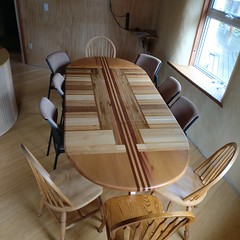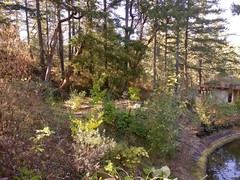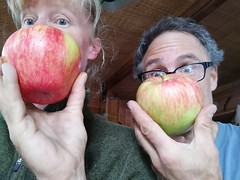This section really should include all the plants… but we have decided to separate out a few plants that do not fall under ‘Fruits and Berries’ or ‘Edible Nuts and Seeds’. We have many plants growing, some very rare, and quantities are limited.
Siberian Ginseng – Eleutherococcus senticosus
The herb grows 2 m at a slow rate, is a deciduous shrub, in mixed and coniferous mountain forests, forming low undergrowth or is found in groups in thickets and edges. It is sometimes found in oak groves at the foot of cliffs, very rarely in high forest riparian woodland. Its native habitat is East Asia, China, Japan, and Russia. E. senticosus is broadly tolerant of soils, growing in sandy, loamy, and heavy clay soils with acid, neutral, or alkaline chemistry and including soils of low nutritional value. It can tolerate sun or dappled shade; we grow ours underneath the shade of Arbutus trees . It is hardy to zone 3, flowers in July in most habitats. The flowers are hermaphroditic and are pollinated by insects.
An exceptional resource paper can be found HERE
Purple Cone Flower – Echinacea purpurea
A herbaceous perennial growing 120 cm (47 in) tall by 25 cm (10 in) wide at maturity. Its habitats include dry open woods, prairies and barrens, as well as cultivated beds. It can withstand drought once established and is hardy to zone 3. Depending on the climate, it blooms throughout spring to late summer. Its individual flowers (florets) within the flower head are hermaphroditic, having both male and female organs on each flower. It is pollinated by butterflies and bees. In Germany over 200 pharmaceuticals preparations are mede with this. Medicinal information can be found many places, but a good source is PFAF
Toona sinensis – Chinese Mahogany or Red Toon or Chinese Cedar
It is a deciduous tree growing to 25 m tall with a trunk up to 70 cm diameter, grows in zone 5, and flowers are hermophrodite. The young leaves of T. sinensis are extensively used as a vegetable in China; they have a floral, yet onion-like flavor, attributed to volatile organosulfur compounds. Tree growth is curtailed when new shoots and leaves are trimmed for a food source and thus can be a smaller garden tree. Plants with red young leaves are considered of better flavour than those where the young leaves are green – we have the Red Toon. How to use it… young shoots and leaves – cooked an is rich in vitamin A, the leaves also contain about 6% protein, 1% fat, 6.6% carbohydrate, 1.5% ash. The leaves can be used as a tea substitute The fruit, bark, and roots are used in traditional Chinese medicine. Toona sinensis can induce apoptosis of cancer cells, reduce plasma glucose in diabetic rats, and improve lipolysis of differentiated 3T3-L1 adipocyte and its uptake of glucose.
The wood is highly valued for furniture making, windows, and in instruments, as well as the wood is burned as incense in Chinese temples. So with all that going… why not?
Ginseng – Panax ginseng
Panax ginseng is a perennial growing to 0.8 m (2ft 7in) by 0.7 m (2ft 4in).
It is hardy to zone 6. The flowers are hermaphrodite (have both male and female organs). Likes moist soil, and shady edge but not deep shade. Very long to germinate from seed and may be some years before we have spare to sell.









